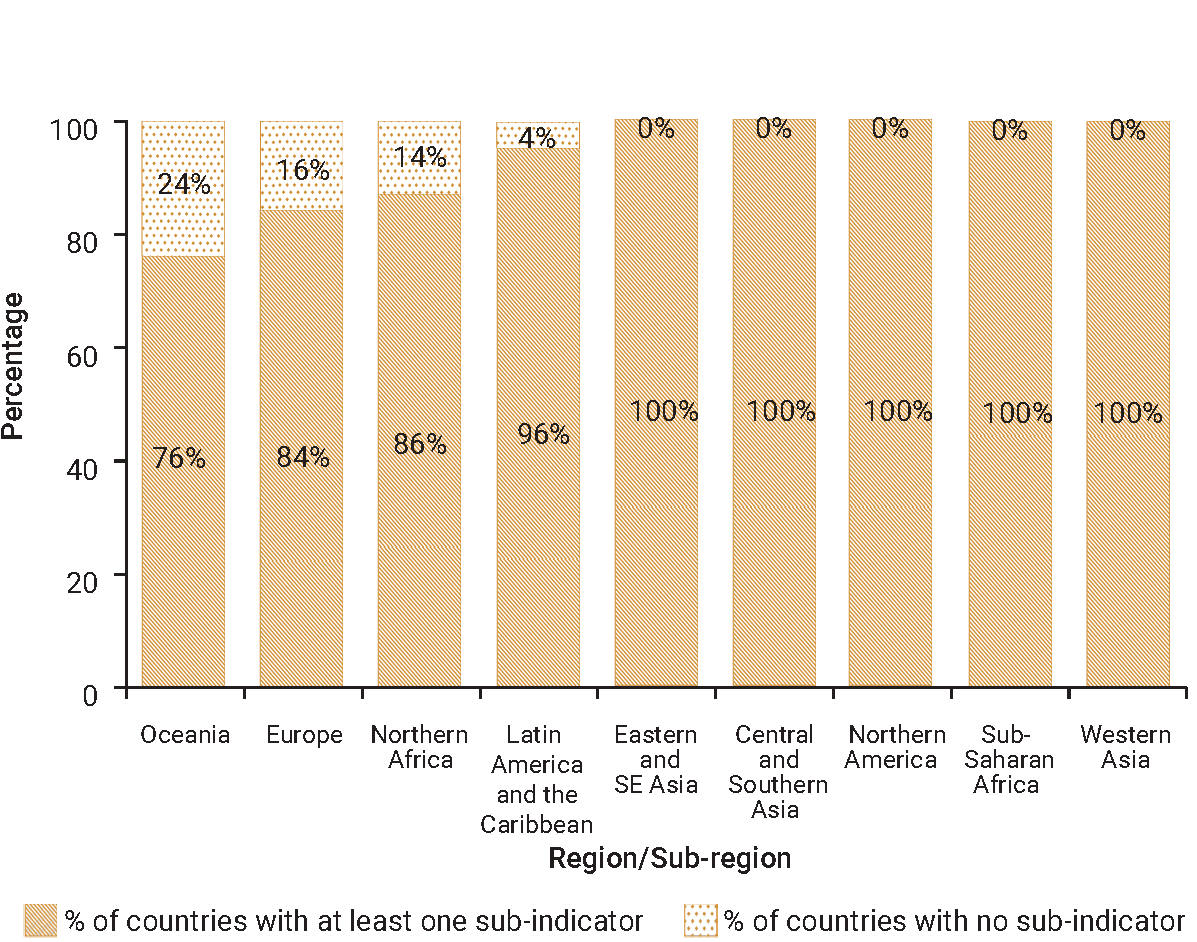SDG Indicator 7.2.1: Renewable energy share in the total final energy consumption
1. Key features and metadata
Definition: This indicator monitors the share of final consumption of energy that is derived from renewable resources.
| Sub-indicator | Disaggregated by |
|---|---|
|
EG_FEC_RNEW Renewable energy share in the total final energy consumption (%) |
No current data disaggregation available. |
Sources of information: Data transmitted by relevant national administrations (e.g. Ministry of Energy or National Statistics Offices) to the International Energy Agency (IEA) and the United Nations Statistics Division (UNSD).
Related SDG Indicators: 7.b.1 (Installed renewable energy-generating capacity in developing countries (in watts per capita)), 9.4.1 (CO2 emission per unit of value added) and 13.2.2 (Total greenhouse gas emissions per year).
2. Data availability by region, SDG Global Database, as of 02 July 2025

3. Proposed disaggregation, links to policymaking and its impact
| Proposed disaggregation | Link to policymaking | Impact |
|---|---|---|
|
Renewable energy share in the total final energy consumption, by sources of energy (%) (UN 2018a; IEA et al.2023):
Applies to:
|
Universal access to sustainable, affordable, reliable, and modern energy depends to a large extent on the growth of renewable energy. It is essential to understand the role each renewable source plays in the overall expected growth. Similarly, at the national level, it is useful to know the respective contribution of each source of renewable energy to national objectives for prioritizing the interventions and bringing support to specific renewable sources. This disaggregation is in line with the UN Global Roadmap for Accelerated SDG7 (UN 2021a). |
Recent policy responses to the energy crisis have led to the development of renewables despite the unfavourable macro-economic outlook, deficient funding and supply chain bottlenecks. A scale-up in all sectors (public and private) to seek the policy momentum for renewable energy is needed to realize SDG 7 and the Paris Agreement. In that respect, particular efforts should be placed on the transition to modern uses of renewables, more efficient uses of biomass and substantial progress in energy conservation (IEA et al.2023). |
|
Renewable energy share in the total final energy consumption, by end use sector (%) (UN 2018a):
Related disaggregation with a focus on transport, electricity and heat raising (IEA et al.2023). Applies to:
|
This disaggregation provides particularly useful information for drawing up sectoral strategies for renewable energy deployment. It also helps identify stronger measures to limit the use of fossil fuel energy sources by sector and promote (through incentives) the use of renewables (IEA et al.2023; UN-DESA 2023a). Each sectoral use has its own specifications which need to be accounted for. This disaggregation is in line with the UN Global Roadmap for Accelerated SDG7 (UN 2021a). |
An improved understanding of the energy demand by end use sectors provides valuable information on where efforts are needed to advance the shift from highly polluting fossil fuels and unsustainable uses of biomass to less polluting energy sources. For example, support for the development of renewable heat technologies to reduce the heat demand in energy-intensive industries. Or support for the electrification of infrastructure and renewable electricity generation in the transport sector. (IEA et al.2023; UN-DESA 2023a). |
|
Share of on-grid/off-grid capacity for solar energy production (%)(IRENA 2022):
|
Power connectivity (i.e. interconnected power grids) can help countries to achieve a range of their energy targets and policy goals. It is pertinent that decision-makers have access to disaggregated information on the ratio of on-grid/off-grid capacity for solar energy production. This disaggregation is notably helpful for identifying and addressing a range of barriers to connectivity development. These include technical barriers (i.e. transmission infrastructure), political barriers (i.e. strong commitments), regulatory barriers (i.e. strategies or plans), institutional barriers, financial barriers (i.e. for stakeholders, public-private partnerships or energy prices), and cultural barriers (UN 2023b; UN-DESA 2023a). It also encourages the development and adoption of evidence-based policies. This disaggregation is in line with the UN Global Roadmap for Accelerated SDG7 (UN 2021a). |
Countries face obstacles in developing their power system connectivity. These include energy security concerns, limited funding capacity, variations in national prices and tariffs, national energy-related subsidy policies, or the exploitation of polluting fossil fuels to generate electricity. Connectivity can increase access to and generation of renewable energy, accelerate its integration, optimize the production and use of energy, and contribute to gender equality (UN 2023b). |

